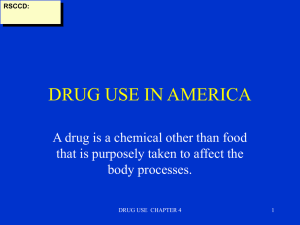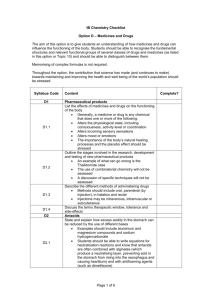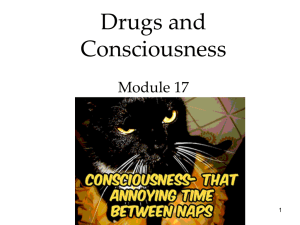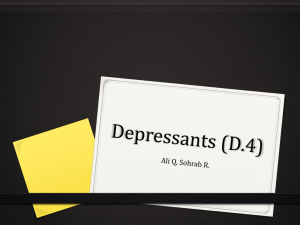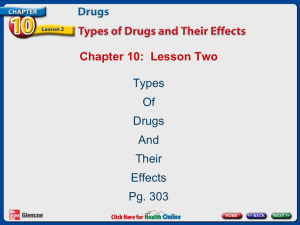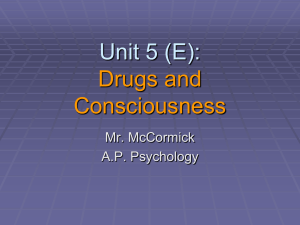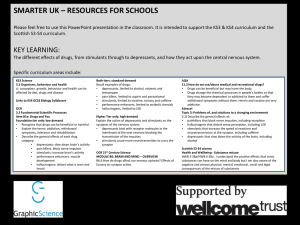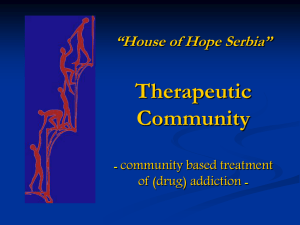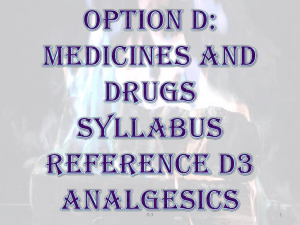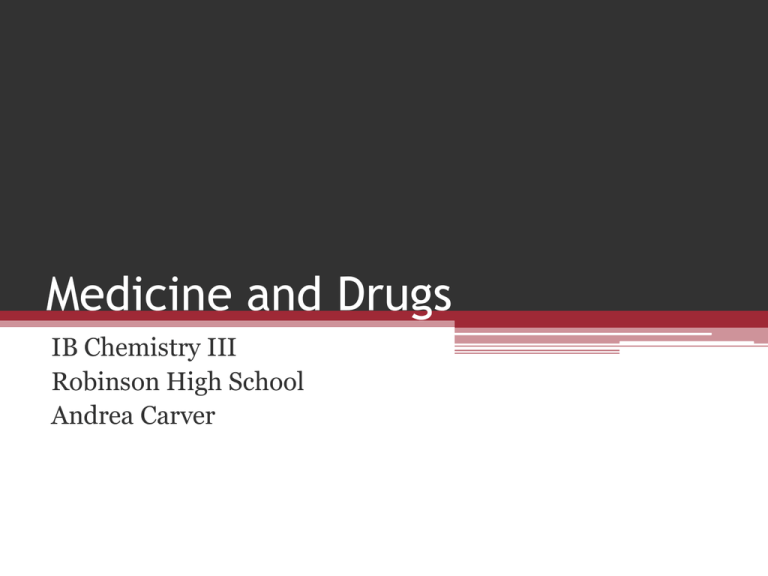
Medicine and Drugs
IB Chemistry III
Robinson High School
Andrea Carver
Introduction
• Natural chemicals have been used for healing
properties for thousands of years.
• In the 20th century, molecules are synthesized
specifically to treat illnesses.
▫ Treatment for smallpox, malaria, tuberculosis, polio
• Problems such as abuse, excesses, and antibiotic
resistance have arisen.
• New diseases necessitate proactive drug
development and distribution.
▫ Avian flu, Ebola, AIDS pandemic
Pharmaceutical Products:
IB Objectives
• D.1.1 List the effects of medicines and drugs on
the functioning of the body.
• D.1.2 Outline the stages involved in research,
development, and testing of new pharmaceutical
products.
• D.1.3 Describe the different methods of
administering drugs.
• D.1.4 Discuss the terms therapeutic window,
tolerance, and side-effects.
The Human Body’s Defense System
• The body responds to many types of defect and
breakdown naturally. It is self-healing.
• The body must also must address the constant
attacks of microorganisms (invaders).
• The immune system consists of complex systems
of defensive and healing processes (lines of
defense).
• Symptoms of illness are often immune system
responses to invading organisms.
▫ Examples: runny nose, fever
Defense Mechanisms
First Defense:
Barriers to Entry
Second Defense:
Innate Immune
System
Third Defense:
Adaptive Immune
System
•Skin
•WBC’s engulf invaders
(phagocytosis)
•WBC’s produce
antibodies to recognize
and destroy the invaders
•Mucous membranes
•Closures and secretions
of natural openings (lips,
eyelids, ear wax, etc.)
Non-specific mechanism
•Blood clotting prevents
blood loss and further
invasion
•Inflammatory response
•Memory cells enable
body to quickly respond
to repeat invasion by
same organism
Non-specific mechanism
Specific mechanism
The Immune System + Medicine
• Medicine should be used to supplement the
natural self-healing processes of the body.
• Goal should be to maximize the effectiveness of
the body’s natural defense mechanisms.
• When is medicine necessary?
• In what cases might medicine be more
detrimental than beneficial?
“Drug” versus “Medicine”
• Drug
▫ Chemical that affects how body works.
▫ May have positive or negative effects.
▫ Associated with illegal substances.
• Medicine
▫ Substance that improves health.
▫ May be natural or synthetic.
▫ Synthetic medicines may include active and
inactive ingredients.
Drug Affects on the Body
• Alteration of physiological state such as
consciousness, activity level, coordination.
• Alteration of incoming sensory sensations.
• Alteration of mood or emotions.
Basic Classification of Drugs
• Analgesics, stimulants, depressants, and
mind-altering drugs affect the nervous
system and brain.
• Antacids target metabolic processes.
• Antibacterials and antivirals help the body
fight infection by microorganisms.
The Placebo Effect
• The placebo effect occurs when patients gain
therapeutic benefits from their belief that they
are taking a useful drug, even though the drug
they have been given is inert.
• Mechanism is unclear.
• May be related to the brains release of natural
healing or pain relieving chemicals.
• Typically experienced by 1/3 of control group.
Routes of Drug Administration
Administration Method
Description
Example
Oral
Taken by mouth
Tablets, capsules, pills
Inhalation
Vapor inhaled; smoking
Asthma medications;
cocaine, nicotine
Skin Patches
Absorbed directly through
skin into blood
Some hormones (estrogen),
nicotine
Suppositories
Inserted into rectum
Drugs for digestive
symptoms, hemorroids
Eye/ear drops
Liquids directly dropped in
Antibiotics for ear/eye
Parenteral- by injection
•Intramuscular
•Intravenous
•Subcutaneous
•Many vaccines
•Local anesthetics
•Dental injections
• Best method of delivery is determined considering chemical
nature of drug, patient condition, and target organ.
Methods of Administration
Physiological Effects of Drugs
• Drugs usually have more than one effect:
▫ Therapeutic Effect
Intended physiological effect
Beneficial
▫ Side Effects
Unintended physiological effects
May be beneficial or adverse
Patients should be monitored and made aware of all
possible side effects of a prescribed drug
Dosing
• Dosing regime- amount of drug per dose and
frequency of doses administered.
▫ Goal is to achieve and maintain a constant
therapeutic concentration of drug in the blood.
• Therapeutic window- the range in
concentration between the therapeutic level and
toxic level of drug in the blood.
▫ Must be above therapeutic level to see benefits.
▫ Must be below toxic level to avoid damaging
effects or death.
Therapeutic Window
Effects of Extended Drug Use/Abuse
• Tolerance- reduced response to a drug following
prolonged use.
▫ Higher dose required for same response which
increases chance of adverse side effects.
▫ May be due metabolic or receptor changes.
• Dependence/Addiction- occurs when individual
needs drug to feel normal.
• Withdrawal symptoms will be experienced if a
dependant individual no longer consumes the drug.
▫ May be mild to severe depending on the drug
Research, Development, Testing of
Drugs
• Steps:
▫ Discovery Research
Identification of Lead Compounds
Synthesis of Analogues
Biological Testing
▫ Development Research
Phase I- 50-100 healthy volunteers
Phase II- 200-400 patients
Phase III- 3000+ patients: double blind study
▫ Regulatory Review
▫ Post-Marketing Monitoring
Thalidomide
• Prescribed for
morning sickness in
early pregnancy
during the 50’s and
60’s.
• Resulted in severe
birth defects.
• Several years before
drug was linked with
malformations.
Vioxx
Remember…..
• All drugs are poisons!
Medicine and Drugs Assignment
• Groups of four will prepare presentations on
each of the following topics:
▫
▫
▫
▫
▫
Analgesics
Depressants
Stimulants
Antibacterials
Antivirals
• Powerpoint presentation must be uploaded to
http://carverchemistry.wikispaces.com/
Project Requirements
• Powerpoint presentations must include:
▫
▫
▫
▫
List IB objectives for topic
Summary of key information on topic
Images which help to clarify main points
Practice questions from textbook.
• Provide class with a concise study sheet in which
each objective is addressed.
• Prepare and review questions and answers to
sample test questions on your topic from IB
question bank.
Antacids: IB Objectives
• D.2.1 State and explain how excess acidity in the
stomach can be reduced by the use of different
bases.
Analgesics: IB Objectives
• D.3.1 Describe and explain the different ways that
analgesics prevent pain.
• D.3.2 Describe the use of derivatives of salicylic acid as
mild analgesics and compare the advantages and
disadvantages of using aspirin and paracetamol
(acetaminophen).
• D.3.3 Compare the structures of morphine, codeine, and
diamorphine (heroin, a semi-synthetic opiate).
• D.3.4 Discuss the advantages and disadvantages of
using morphine and its derivatives as strong analgesics.
• D.3.5 Identify other commonly used depressants and
describe their structures.
Depressants: IB Objectives
• D.4.1 Describe the effects of depressants.
• D.4.2 Discuss the social and physiological
effects of the use and abuse of ethanol.
• D.4.3 Describe and explain the techniques used
for the detection of ethanol in the breath, the
blood, and urine.
• D.4.4 Describe the synergistic effects of ethanol
with other drugs.
• D.4.5 Identify other commonly used
depressants and describe their structures.
Stimulants: IB Objectives
• D.5.1 List the physiological effects of stimulants.
• D.5.2 Compare amphetamines and epinephrine
(adrenaline).
• D.5.3 Discuss the short- and long-term effects of
nicotine consumption.
• D.5.4 Describe the effects of caffeine and
compare its structure with that of nicotine.
Antibacterials: IB Objectives
• D.6.1 Outline the historical development of
penicillins.
• D.6.2 Explain how penicillins work and discuss
the effects of modifying the side-chain.
• D.6.3 Discuss and explain the importance of
patient compliance and the effect of penicillin
overprescription.
Antivirals: IB Objectives
• D.7.1 State how viruses differ from bacteria.
• D.7.2 Describe the different ways in which
antiviral drugs work.
• D.7.3 Discuss the difficulties associated with
solving the AIDS problem.
Drug Action: IB Objectives
• D.8.1 Describe the importance of geometrical
isomerism in drug action.
• D.8.2 Discuss the importance of chirality in
drug action.
• D.8.3 Explain the importance of the beta-lactam
ring action of penicillin.
• D.8.4 Explain the increased potency of
diamorphine (heroin) compared to morphine.
Drug Design: IB Objectives
• D.9.1 Discuss the use of a compound library in drug
design.
• D.9.2 Explain the use of combinatorial and parallel
chemistry to synthesize new drugs.
• D.9.3 Describe how computers are used in drug
design.
• D.9.4 Discuss how the polarity of a molecule can be
modified to increase its aqueous solubility and how
this facilitates its distribution around the body.
• D.9.5 Describe the use of chiral auxillaries to form
the desired enantiomer.
Mind-Altering Drug: IB Objectives
• D.10.1 Describe the effects of lysergic acid
diethylamide (LSD), mescaline, psilocybin, and
tetrahydrocannabinol (THC).
• D.10.2 Discuss the structural similarities and
differences between LSD, mescaline, and
psilocybin.
• D.10.3 Discuss the arguments for and against
the legalization of cannabis.

